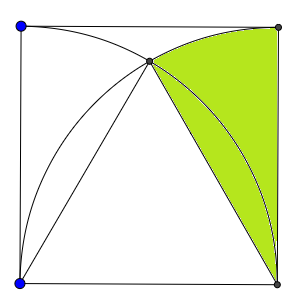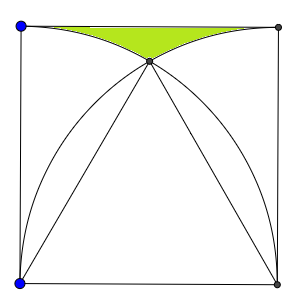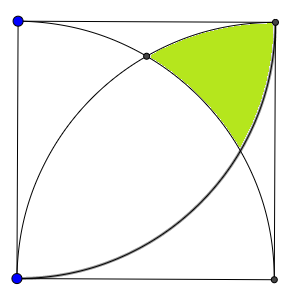Problem:
Solution:
For part (a), the number of monomials is easy to count by listing them in a pyramid like this
$
\begin{array}{cccc}
x^0 & & & \\
x^1 & y^1 & & \\
x^2 & x^1y^1 & y^2 & \\
\cdots & \cdots & \cdots & \\
x^m & x^{m-1}y^1 & \cdots & y^m
\end{array}
$
Now counting them is trivial, it is just $ 1 + 2 + \cdots + (m + 1) = \frac{(m+1)(m+2)}{2} $
For part (b), I read part (c) as a hint. It doesn't quite mention what does it mean by "monomial" and "linear dependent".
I figured it actually means regarding polynomial as vectors. Notice when we add two polynomials, we need to match the degree when we add terms together, so a polynomial is really a vector (can be think of as tuple of numbers).
Now, let imagine if we expand $ [f(t)]^a[g(t)]^b $, the lowest degree term is constant, and the highest degree term is $ t^{na}t^{nb} \le t^{mn} $, and the expansion could have terms of any power of $ t $ in between. We can then think of them as vector space of dimension $ mn + 1 $
If we think of the collection of all polynomials of form $ [f(t)]^a[g(t)]^b $, by part (a), there are $ \frac{(m+1)(m + 2)}{2} $ of them, and all of them are vectors of dimension $ mn + 1 $, so if $ \frac{(m+1)(m + 2)}{2} > mn + 1 $, then by definition these vectors must be linear dependent.
As for part (c), we know those 'vectors' are linear dependent. We can find ourselves a formula $ \sum a_i p_i = 0 $, because these $ p_i $ are just $ x^a y^b $, so the overall formula is a polynomial in $ k[x, y] $.
Suppose a point is on the parametric curve, we know for sure that it is on the polynomial we found. On the other hand, for a point on the polynomial, we do NOT really know if it is on the parametric curve or not, that's why the problem is carefully crafted and say that the parametric curve is contained in the variety, not that the parametric curve IS the variety.
Part (d) is basically the same idea as part (b) and (c) except we go up one dimension. We consider the 'monomial' $ [f(t, u)]^a[g(t, u)]^b[h(t, u)]^c $.
To count the number of these 'monomials', we need to be more imaginative. Consider a pile of balls arranged in a tetrahedral shape like this.
The red ball represents the 'monomial' $ [f(t,u)]^0[g(t, u)]^0[h(t, u)]^0 $, the blue ball represents $ [f(t,u)]^1[g(t, u)]^0[h(t, u)]^0 $ and so on. The total number of 'monomials' is known as the tetrahedral numbers and there is $ \frac{m(m+1)(m+2)}{6} $ of them.
The total number of terms in such expression, however, is going to be bounded by the degree of $ t $ and $ u $ just like what we did in part (b). The maximum degree in $ t $ and $ u $ is both mn. So there can be at most $ (mn + 1)^2 $ terms.
Therefore we can still pick $ m $ such that $ \frac{m(m+1)(m+2)}{6} > (mn+1)^2 $ and therefore we can still argue for the vectors being linearly dependent.
Once we have that linear dependency, we can have the $ \sum a_i p_i = 0 $ expression again, and once again that will be our $ F $ for the surface case!
Solution:
For part (a), the number of monomials is easy to count by listing them in a pyramid like this
$
\begin{array}{cccc}
x^0 & & & \\
x^1 & y^1 & & \\
x^2 & x^1y^1 & y^2 & \\
\cdots & \cdots & \cdots & \\
x^m & x^{m-1}y^1 & \cdots & y^m
\end{array}
$
Now counting them is trivial, it is just $ 1 + 2 + \cdots + (m + 1) = \frac{(m+1)(m+2)}{2} $
For part (b), I read part (c) as a hint. It doesn't quite mention what does it mean by "monomial" and "linear dependent".
I figured it actually means regarding polynomial as vectors. Notice when we add two polynomials, we need to match the degree when we add terms together, so a polynomial is really a vector (can be think of as tuple of numbers).
Now, let imagine if we expand $ [f(t)]^a[g(t)]^b $, the lowest degree term is constant, and the highest degree term is $ t^{na}t^{nb} \le t^{mn} $, and the expansion could have terms of any power of $ t $ in between. We can then think of them as vector space of dimension $ mn + 1 $
If we think of the collection of all polynomials of form $ [f(t)]^a[g(t)]^b $, by part (a), there are $ \frac{(m+1)(m + 2)}{2} $ of them, and all of them are vectors of dimension $ mn + 1 $, so if $ \frac{(m+1)(m + 2)}{2} > mn + 1 $, then by definition these vectors must be linear dependent.
As for part (c), we know those 'vectors' are linear dependent. We can find ourselves a formula $ \sum a_i p_i = 0 $, because these $ p_i $ are just $ x^a y^b $, so the overall formula is a polynomial in $ k[x, y] $.
Suppose a point is on the parametric curve, we know for sure that it is on the polynomial we found. On the other hand, for a point on the polynomial, we do NOT really know if it is on the parametric curve or not, that's why the problem is carefully crafted and say that the parametric curve is contained in the variety, not that the parametric curve IS the variety.
Part (d) is basically the same idea as part (b) and (c) except we go up one dimension. We consider the 'monomial' $ [f(t, u)]^a[g(t, u)]^b[h(t, u)]^c $.
To count the number of these 'monomials', we need to be more imaginative. Consider a pile of balls arranged in a tetrahedral shape like this.
The red ball represents the 'monomial' $ [f(t,u)]^0[g(t, u)]^0[h(t, u)]^0 $, the blue ball represents $ [f(t,u)]^1[g(t, u)]^0[h(t, u)]^0 $ and so on. The total number of 'monomials' is known as the tetrahedral numbers and there is $ \frac{m(m+1)(m+2)}{6} $ of them.
The total number of terms in such expression, however, is going to be bounded by the degree of $ t $ and $ u $ just like what we did in part (b). The maximum degree in $ t $ and $ u $ is both mn. So there can be at most $ (mn + 1)^2 $ terms.
Therefore we can still pick $ m $ such that $ \frac{m(m+1)(m+2)}{6} > (mn+1)^2 $ and therefore we can still argue for the vectors being linearly dependent.
Once we have that linear dependency, we can have the $ \sum a_i p_i = 0 $ expression again, and once again that will be our $ F $ for the surface case!







































